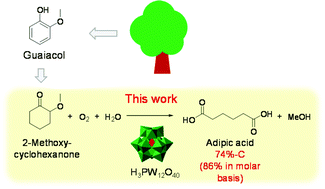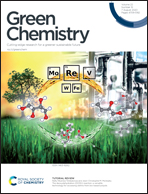Efficient production of adipic acid from 2-methoxycyclohexanone by aerobic oxidation with a phosphotungstic acid catalyst†
Abstract
Oxidative cleavage reaction of 2-methoxycyclohexanone (2-MCO) to adipic acid (AA) and methanol with O2 in water solvent was investigated. 2-MCO and AA are one of the lignin-based compounds produced via hydrogenation of guaiacol and an important monomer in industry, respectively. Various vanadium compounds and heteropolyacids were tested as homogeneous catalysts because vanadium compounds, especially phosphomolybdovanadic acids, have been known to be active in various oxidative cleavage reactions with O2. Simple vanadium-free phosphotungstic acid (H3PW12O40), which has not been regarded as an oxidation catalyst using O2 as the oxidant, showed good catalytic activity and excellent selectivity to AA. The carbon-based AA yield reached 74% (86% in molar basis) and this value was higher than those obtained with vanadium-based catalysts. A reuse test and 31P NMR confirmed that the H3PW12O40 catalyst was stable and reusable. Kinetic studies and the reaction test using a radical inhibitor suggested that the reaction mechanism is not auto-oxidation involving free radicals. Instead, the substrate was first activated by one-electron oxidation by H3PW12O40 catalyst and then reacted with O2.



 Please wait while we load your content...
Please wait while we load your content...